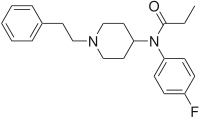Parafluorofentanyl
 |
|
| Clinical data | |
|---|---|
| ATC code |
|
| Legal status | |
| Legal status |
|
| Identifiers | |
|
|
| CAS Number | |
| PubChem CID | |
| ChemSpider | |
| UNII | |
| ChEBI | |
| Chemical and physical data | |
| Formula | C22H27FN2O |
| Molar mass | 354.461 g/mol |
| 3D model (Jmol) | |
|
|
|
|
Parafluorofentanyl (4-Fluorofentanyl) is an opioid analgesic being an analogue of fentanyl developed by Janssen Pharmaceutica in the 1960s.
4-Fluorofentanyl was sold briefly on the US black market in the early 1980s, before the introduction of the Federal Analog Act which for the first time attempted to control entire families of drugs based on their structural similarity rather than scheduling each drug individually as they appeared. 4-Fluorofentanyl is made with the same synthetic route as fentanyl, but by substituting para-fluoroaniline for aniline in the synthesis.
Side effects of fentanyl analogs are similar to those of fentanyl itself, which include itching, nausea and potentially serious respiratory depression, which can be life-threatening. Fentanyl analogs have killed hundreds of people throughout Europe and the former Soviet republics since the most recent resurgence in use began in Estonia in the early 2000s, and novel derivatives continue to appear.
...
Wikipedia
